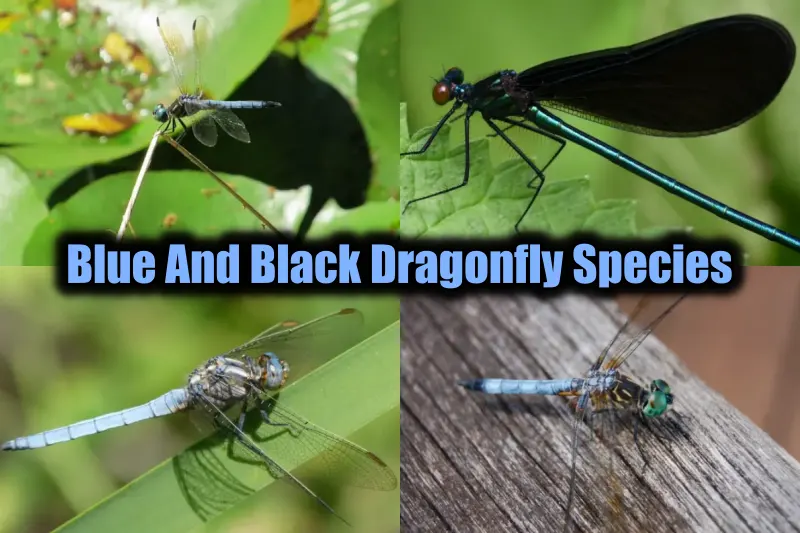Earth has beautiful species of creatures. Every creature has its own specialty. Each of them has different abilities; some can fly, swim, run, etc. Among all the flying creatures, we are going to talk about the dragonfly. Have you ever seen a blue and black dragonfly? Today we are going to talk about 10 blue and black dragonflies. Here we go.
10 Blue and Black Dragonfly
1. Ebony Jewelwing Dragonfly
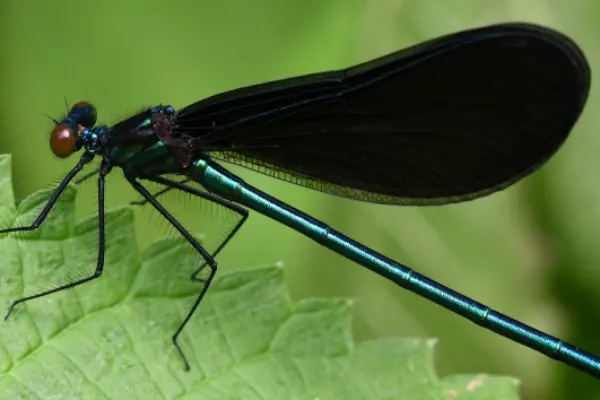
| Scientific name | Calopteryx maculata |
| Identification | metallic blue-green body |
| Geographical location | eastern U.S. and southeastern Canada |
The ebony jewelwing, a broad-winged damselfly species found in the eastern U.S. and southeastern Canada, is known for its shiny, metallic blue-green bodies and black wings.
The male has a metallic blue-green body and black wings, while the female is duller brown with smoky wings with white spots near the tips. The naiad is pale brown with darker markings.
The ebony jewelwing is a beautiful iridescent green damselfly with large black wings that flutters around streams in wooded areas.
Young adults have lighter, more transparent wings, while older individuals have solid black wings. Males have all-black wings and brilliantly metallic blue-green bodies, while females are duller and more brownish, each with a white spot near the tip.
2. Blue-eyed Darner
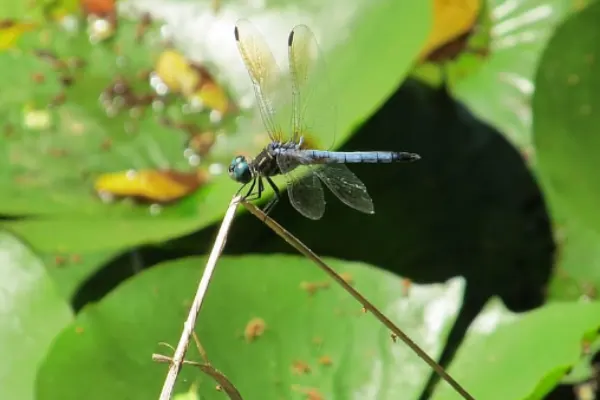
| Scientific name | Rhionaeschna multicolor |
| Identification | bright blue eyes |
| Geographical location | western United States |
The blue-eyed darner is a common dragonfly native to the western United States, found in the sagebrush steppe of the Snake River Plain. The darner hunts small flying insects while on the wing.
Both males and females have bright blue eyes, with the male being dark brown to brownish black. The thorax has two blue stripes and diagonal stripes on each side. The abdomen has large and small blue spots.
The anal appendages are forked, with the female marking similarly to the male but with a brown base color and green markings. The darner is typically the second-earliest to emerge in spring.
3. Emperor Dragonfly
|
Scientific name |
Anax imperator |
|
Identification |
pale blue abdomen with a black line running down the whole body |
|
Geographical location |
Asia, Africa, and Europe |
The emperor dragonfly is a large, mostly blue species with a pale blue abdomen and a black stripe running the length of its body. Its wings are transparent with thin black lines, attached by a separate muscle, providing a wide range of movement.
The females are green with a dark stripe down the abdomen, while the males have a bright blue abdomen and a green thorax. The legs are brownish, black, and yellow.
4. Lesser Emperor Dragonfly
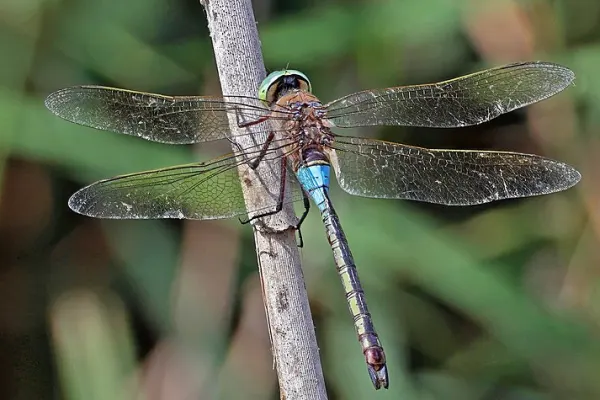
|
Scientific name |
Anax parthenope |
|
Identification |
irregular black mid dorsal stripe |
|
Geographical location |
Southern Europe, North Africa, the Middle East, and Asia |
Anax parthenope, also known as the lesser emperor, is a crepuscular dragonfly found in southern Europe, North Africa, the Middle East, and Asia. Its multicolored upper surface of frons and anal appendages distinguishes it from other species.
The labium and labrum are golden yellow, while the face and frons are greenish yellow. The eyes are green and bluish when aged, and the thorax is pale olivaceous brown with dark brown sutures.
Segment two of the abdomen is turquoise blue, while segments 4 to 9 have an irregular black middorsal stripe.
5. Blue Corporal Dragonfly

|
Scientific name |
Ladona deplanata |
|
Identification |
short black streaks on the wings |
|
Geographical location |
North America and the eastern United States |
The blue corporal, also known as the little corporal, is a dragonfly native to North America and the eastern United States. This blue and black dragonfly is characterized by vivid blue coloring, with the male having a dark brown thorax and a pale blue abdomen.
The female has a brown face and eyes, and both sexes have clear wings with short black streaks at the base. The male’s abdomen and much of the body are blue, while the female’s face and eyes are brown.
The species is small compared to other Eastern US dragonflies, measuring 29–40 mm in length. Some larger Blue Corporal dragonflies can reach up to 1.6 inches in size.
6. Spangled Skimmer Dragonfly
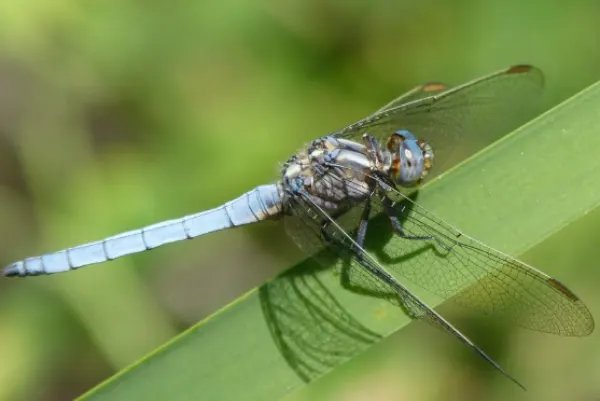
|
Scientific name |
Libellula cyanea |
|
Identification |
Transparent wings with black and white spots at the edges |
|
Geographical location |
the United States |
Spangled Skimmer dragonflies, primarily found in US lakes, are characterized by their blue coloration across their bodies and abdomens. Males are blue with a dark head, while females are dark brown with yellow stripes and darkish wingtips.
The head is black, while the wings are transparent. Females have black bodies with yellow bands and brown eyes.
Off-white, smaller marks are found on the forewings and hindwings of females, unlike the larger, bright white marks on male wings. Spangled Skimmers have an extended season from spring to fall.
7. Little Blue Dragonlet
|
Scientific name |
Erythrodiplax minuscula |
|
Identification |
light blue color with black segments |
|
Geographical location |
North America, Florida |
The Little Blue Dragonlet is a species of skimmer native to North America known for its small size, blue coloration, and black segments of the abdomen.
Its males have a light blue color with black segments, while females are dominated by black and yellow colors.
This blue and black dragonfly species is found in southeastern US habitats, such as Florida, and can be seen from spring to fall.
Small blue sections are found below the large brown eyes of females. The Little Blue Dragonlet prefers ponds and lakes and is rarely found next to large rivers.
8. Band-winged Dragonlet
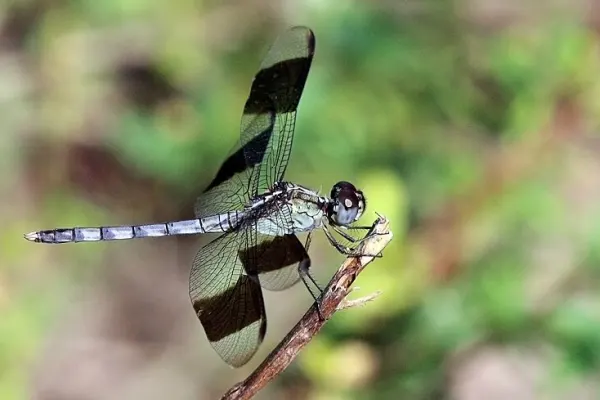
|
Scientific name |
Erythrodiplax umbrata |
|
Identification |
rectangular black bands on its wings |
|
Geographical location |
Central America, Texas, and Florida |
The male of the band-winged Dragonlet is a dark, slender, mid-sized skimmer with large, rectangular black bands on its wings. Females, sometimes with banded wings, lack wing markings and are mostly drab brownish in color.
Heteromorph females can be identified by dark brown marks along the side of the abdomen.
This species inhabits parts of Central America, Texas, and Florida, with a dark blue body that is almost black in males and yellow coloring without black bands on wings for females.
The species grows to a size between 30 and 40mm, making it a medium-sized dragonfly.
9. California Darner Dragonfly
|
Scientific name |
Rhionaeschna californica |
|
Identification |
bluish-green diagonal stripes on each side of the thorax |
|
Geographical location |
Central and North America |
The California darner, a species of dragonfly in the Aeshnidae family, is a medium-sized dragonfly found in Central and North America. Its males are dark brown to brownish black, with blue to bluish green diagonal stripes on each side of the thorax.
The abdomen is marked with large blue spots alternating with smaller greenish dots and several wide blue bands circling the abdomen near the thorax.
Most females resemble the males, but some may have greenish-yellow markings instead. The species has black and blue males, with a black head with large blue eyes and brown spots on the central dorsal side.
10. Variable Darner Dragonfly

|
Scientific name |
Aeshna interrupta |
|
Identification |
black body with large blue spots |
|
Geographical location |
U.S., Canada, New Mexico, Arizona, and California |
The variable darner is known for its black and blue coloring, with a black body with large blue spots and a black face. Found across Canada and most US states, it is known for its ability to tolerate saline conditions.
Its black body with large blue spots and black face are distinctive features. Variable darner dragonflies are found across Canada and most US states.
11. Blue Dasher Dragonfly
| Scientific name | Pachydiplax longipennis |
| Identification | Yellow-striped thorax |
| Geographical location | United States |
The blue dasher is a common and widespread insect in North America and the Bahamas, belonging to the skimmer family. Its males are bright blue with yellow-striped thorax and metallic green eyes, while females have a distinct brown and yellow striping abdomen with red eyes. Both sexes develop a frosted color with age. The blue dasher exhibits aggression in finding mates and foraging, and is not under any conservation threats.
12. Eastern pondhawk
| Scientific name | Erythemis simplicicollis |
| Identification | Green face |
| Geographical location | United States, southern Ontario and Quebec, Canada |
Erythemis simplicicollis, also known as the common pondhawk, is a dragonfly native to the eastern two-thirds of the United States and southern Ontario and Quebec, Canada.
It is distinguished by its bright green female with a banded abdomen and blue mature male with a green face and thorax.
Nymphs have green eyes and mature adults have a metallic green sheen.
The wings are veined and have dark margins near the apices. The dragonfly’s length is 36 to 48 mm.
13. Blue corporal
| Scientific name | Ladona deplanata |
| Identification | Black face and brown eyes |
| Geographical location | Eastern United States |
The blue corporal, also known as little corporal, is a small, thickset dragonfly in the Libellulidae family.
It is common in the eastern United States and has a dark brown thorax with bluish stripes and a pruinose blue abdomen.
The male has a black face and brown eyes, while the female has a brown face and eyes.
Both sexes have clear wings with short black streaks at the base, often with a smaller amber streak between them.
Conclusion
These are some beautiful blue and black dragonflies. This is it for today; we will be back with some more informative articles. Till then, stay tuned with us on How It See.
Also Read:

As a content writer, I like to write about different niches. I have a curiosity about nature and animals. And like to learn about them. Through my writing, I like to share my experience and knowledge with you. I hope you are enjoying it too.
